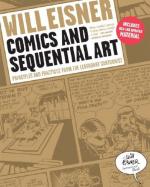
|
| Name: _________________________ | Period: ___________________ |
This test consists of 15 multiple choice questions and 5 short answer questions.
Multiple Choice Questions
1. What determines how successfully the commonality of the human body is conveyed?
(a) The artist's business.
(b) The artist's style.
(c) The artist's skill.
(d) The artist's memory.
2. Why is the face the most important part of the body in comics?
(a) It reveals the personality.
(b) It reveals nothing.
(c) It shows who is who.
(d) It is fun to draw.
3. What was used initially to create code that can be memorized and deciphered?
(a) Repetitive glyphs.
(b) Summary.
(c) Repetitive summary.
(d) Reproduction.
4. What are amorphics?
(a) Thought transformations.
(b) Representations of heat and light
(c) Thoughts that flow in waves.
(d) The pain or glow of love and inner conflicts.
5. What must be followed completely by the artist and writer?
(a) The painting process.
(b) The writing process.
(c) The thinking process.
(d) The drawing process.
6. What does Chapter 5 examine?
(a) Narrative.
(b) Sequence.
(c) Framing.
(d) Expressive anatomy.
7. What does Eisner think light implies?
(a) Comfort.
(b) Fear.
(c) Safety.
(d) Love.
8. What gives voice to thoughts and gives meaning to action?
(a) Monologue.
(b) Soliloquy.
(c) Dialog.
(d) Analog.
9. What do purely instructional comics often use to show relevance?
(a) Sorrow.
(b) Indifference.
(c) Pain.
(d) Humor.
10. What must convey both time and emotion, according to Chapter 5?
(a) Emotion and Instinct.
(b) Time and emotion.
(c) Time and travel.
(d) Thought and emotion.
11. Who is the artist at the mercy of?
(a) The commentator's shop.
(b) The engraver's shop.
(c) The copywriter's shop.
(d) The publisher's shop.
12. How can instructional comics be divided?
(a) Technical and inspirational.
(b) Attitudinal and longitudinal.
(c) Technical and attitudinal.
(d) Technical and latitudinal.
13. What is the face sometimes treated as?
(a) An appendage.
(b) A blight.
(c) A facet.
(d) A ligament.
14. How many points does Eisner say an artist must understand about how objects work?
(a) Five.
(b) Eleven.
(c) Ten.
(d) Six.
15. When can artists render color directly over line work?
(a) When the color is added to transparent overlays.
(b) When the electronic scanner engraves the comic.
(c) When color process engraving by electronic scanning method arrives.
(d) When the lines dissolve.
Short Answer Questions
1. What must artists know about the force of gravity?
2. What is the most universal image in sequential art?
3. What must the artist deal with to decide when abbreviations or omissions are required?
4. What do the writer and artist "pledge allegiance" to when working on comics together?
5. How many panels must an action sometimes be broken into to clarify the action?
|
This section contains 424 words (approx. 2 pages at 300 words per page) |

|




